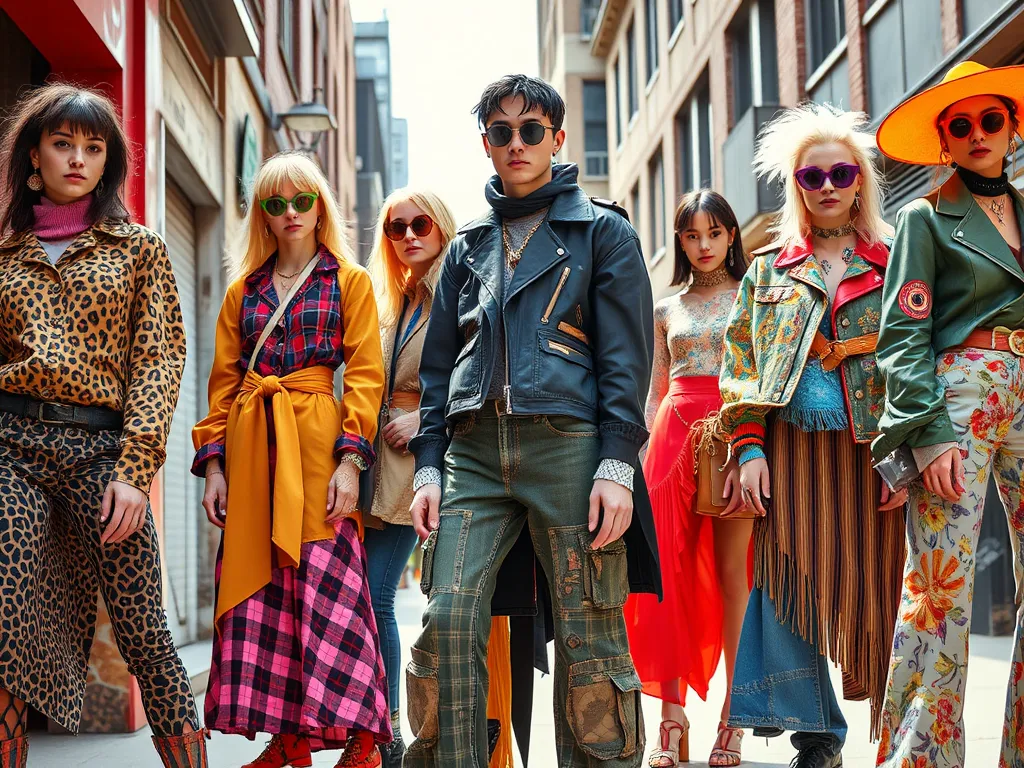Discover Unique Fashion Styles That Stand Out in 2023

Exploring Unique Fashion Styles
Unique Fashion Styles encompass a myriad of aesthetics and expressions that allow individuals to showcase their personality and creativity through clothing. From unconventional silhouettes to vibrant patterns, the world of unique fashion is ever-evolving, reflecting the diverse tastes and preferences of people around the globe. This article delves into various unique fashion styles, offering insight into their origins, key elements, and how to incorporate them into your wardrobe.
The pursuit of Unique Fashion Styles often leads to a blend of cultural influences, historical references, and modern trends. With the rise of social media, unique fashion expressions have gained popularity as people showcase their distinct looks, inspiring others to break away from the conventional and embrace individuality. The challenge lies in finding a unique style that resonates personally while also making a fashionable statement.
Uniqueness in fashion is not just about standing out; it's about self-expression and confidence. Many fashion enthusiasts find joy in experimenting with different styles, mixing and matching various elements to create a look that is authentically theirs. This exploration can involve revisiting vintage trends, adopting elements from different cultures, or embracing avant-garde concepts that push the boundaries of traditional fashion.
As fashion continues to evolve, unique styles are continually redefined by emerging designers and influencers. This evolution encourages diversity and inclusivity within the fashion industry, prompting a celebration of differences rather than conformity. Whether it's through bold colors, striking patterns, or innovative silhouettes, unique fashion styles serve as a canvas for self-discovery and empowerment in an often homogenized world.
In this article, we will explore several Unique Fashion Styles such as Bohemian, Streetwear, Vintage, Minimalist, and Cottagecore. Each style possesses its own distinctive characteristics, history, and appeal. By understanding these styles, you can discover new ways to enhance your wardrobe and embrace your unique fashion identity.
Bohemian Fashion Styles
Bohemian fashion, often referred to as 'Boho' style, has its roots in the 1960s and 1970s, when artists, musicians, and free spirits embraced a lifestyle that challenged societal norms. The Bohemian aesthetic draws inspiration from various cultures, particularly those of Eastern European, Indian, and Native American origins, resulting in an eclectic mix of patterns, textures, and colors.
Key elements of Bohemian style include flowing fabrics, earthy tones, layered clothing, and intricate embroidery. Floral prints, paisley patterns, and ethnic accessories are common features. Bohemian fashion tends to emphasize comfort, allowing wearers to express their individuality through unconventional silhouettes and artistic designs.
To wear Bohemian clothing, opt for maxi dresses, loose-fitting blouses, and relaxed-fit trousers. Layering is essential in creating a Bohemian look, so don't be afraid to mix and match different prints and textures. Pair your outfits with oversized shawls, denim jackets, or eclectic vests for added flair.
Exploring different cultures can inspire you to embrace and create your own Unique Fashion Styles that stand out.
Accessories play a vital role in complementing Bohemian fashion. Consider oversized hats, chunky jewelry, and leather sandals. Scarves can be used creatively as headbands or belts. Incorporating natural materials like wood, feathers, and stones into your accessories adds an authentic touch to the Bohemian vibe.
Modern interpretations of Bohemian style continue to evolve, blending with contemporary elements to create fresh looks. Many fashion designers now incorporate sustainable practices, using eco-friendly materials to align with the values of the modern Bohemian movement, making it not only a fashion statement but also a lifestyle choice.
Streetwear Fashion Styles
Streetwear fashion originated in the 1980s and 1990s, drawing inspiration from urban culture, skateboarding, and hip-hop. It emphasizes casual, comfortable clothing that reflects the attitude and ethos of the streets. Streetwear has evolved into a global phenomenon, with its roots firmly planted in youth culture and social movements.
Key brands such as Supreme, Off-White, and Fear of God have become synonymous with streetwear culture. These brands often employ limited releases and collaborations, creating a sense of exclusivity and desirability. The intersection of fashion and art is prevalent, with many streetwear pieces showcasing bold graphics and unique designs.
Streetwear style icons, such as Kanye West, Tyler, The Creator, and Virgil Abloh, have significantly contributed to the popularity and evolution of this fashion genre. Their influence showcases the power of personal branding and how it can impact fashion trends within the streetwear community.
To create a streetwear look, start with comfortable, relaxed-fitting clothing such as oversized hoodies and joggers. Layer your outfits with graphic tees, denim jackets, or bomber jackets. Footwear, particularly sneakers, is an essential aspect of streetwear, so invest in trendy and stylish sneaker options to complete your look.
The evolution of streetwear trends has witnessed the fusion of high fashion and street culture. Luxury brands are increasingly integrating streetwear elements into their collections, blurring the lines between couture and casual wear. This evolution reflects a broader cultural shift and the growing acceptance of diverse fashion expressions in mainstream media.
Vintage Fashion Styles
Vintage fashion encompasses styles from bygone eras, often defined by specific decades. Each decade brings its own unique flair—be it the flapper dresses of the 1920s, the psychedelic prints of the 1960s, or the glam rock aesthetics of the 1970s. Vintage fashion celebrates nostalgia while providing sustainable alternatives to fast fashion.
Incorporating vintage pieces into your wardrobe can elevate your style and set you apart. Look for signature items like retro dresses, high-waisted trousers, or classic leather jackets. Mixing vintage pieces with modern clothing creates an interesting and timeless appeal that showcases individual taste.
Popular vintage stores and markets abound in cities across the globe, catering to vintage enthusiasts. From thrift shops to curated boutiques, these spaces offer a treasure trove of unique finds. Online platforms have also emerged, making vintage shopping more accessible for individuals worldwide.
Sustainable vintage shopping promotes the idea of reusing and recycling clothing, reducing waste, and embracing conscious consumption. It encourages fashion enthusiasts to be mindful of their purchases while preserving the charm and character of vintage clothing.
The rise of retro fashion styles continues to gain momentum, with contemporary designers frequently drawing inspiration from past decades. This resurgence reflects a collective appreciation for timeless fashion and the desire for individuality in an era dominated by fast fashion trends.
Minimalist Fashion Styles
Minimalist fashion is characterized by simplicity, clean lines, and a neutral color palette. It emphasizes the idea that less is more, focusing on quality over quantity. Minimalist fashion aims to create a cohesive wardrobe that can be mixed and matched effortlessly, maintaining a polished and sophisticated aesthetic.
Building a capsule wardrobe is central to minimalist fashion. A capsule wardrobe typically consists of versatile, timeless pieces that can be worn in various combinations. Key items often include tailored blazers, classic white shirts, and well-fitted jeans—essentials that transcend trends.
Minimalist outfit inspiration can be drawn from fashion icons known for their refined styles, such as Audrey Hepburn and Steve Jobs. Embrace monochromatic looks, play with textures, and incorporate statement accessories sparingly to enhance your overall appearance.
The impact of minimalist fashion on sustainability is significant. By encouraging a mindful approach to fashion consumption, minimalist styles promote a reduction in waste and encourage individuals to invest in high-quality, ethically produced garments that stand the test of time.
Many brands now focus on promoting minimalist aesthetics, offering high-quality essentials and sustainable practices. Brands such as Everlane, Reformation, and COS are leading the way, showcasing that minimalist fashion can be both stylish and environmentally friendly.
Cottagecore Fashion Styles
Cottagecore fashion is rooted in romanticism and nostalgia, drawing inspiration from pastoral aesthetics and rural life. This style romanticizes simplicity and tranquility, invoking a lifestyle that celebrates nature, handicrafts, and the beauty of everyday moments.
Key characteristics of cottagecore style include flowing dresses, embroidered blouses, and earthy tones. Floral prints, oversized cardigans, and handmade accessories create a cozy and comforting aesthetic that resonates with the ethos of rural living and self-sufficiency.
To achieve the cottagecore look, incorporate vintage-inspired pieces and natural fabrics like cotton and linen. Layering is essential; combine long skirts with knitted sweaters or shawls for that effortless, homely vibe. Don't forget to embrace the charm of handmade items and artisanal accessories.
Cottagecore accessories and footwear often feature vintage or rustic elements. Think woven baskets, floral crowns, and simple leather sandals. These accessories can enhance your overall look, further emphasizing the cozy, whimsical essence of cottagecore style.
The cultural significance of cottagecore fashion has gained traction, particularly during the COVID-19 pandemic as people sought comfort and solace in simpler lifestyles. This movement encourages a return to nature and self-care, echoing a growing desire for environmental consciousness and mental well-being in the face of modernity.
